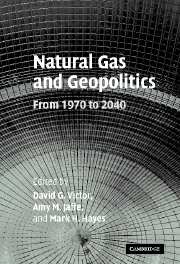Book contents
- Frontmatter
- Contents
- List of figures
- List of tables
- List of boxes
- List of contributors
- Foreword by James A. Baker, III
- Acknowledgments
- List of acronyms and abbreviations
- Part I Introduction and context
- Part II Historical case studies
- Part III International gas trade economics
- Part IV Implications
- Appendix: Technical notes
- Index
- References
Appendix: Technical notes
Published online by Cambridge University Press: 22 September 2009
- Frontmatter
- Contents
- List of figures
- List of tables
- List of boxes
- List of contributors
- Foreword by James A. Baker, III
- Acknowledgments
- List of acronyms and abbreviations
- Part I Introduction and context
- Part II Historical case studies
- Part III International gas trade economics
- Part IV Implications
- Appendix: Technical notes
- Index
- References
Summary
For any country, a variety of statistical sources for natural gas exist: (1) the IEA produces detailed statistics on gas production and export/import and consumption by sectors; (2) Eurostat, the European Union's statistical body, produces less detailed but more up-to-date statistics on gas use and supply in the member countries; (3) for each country, government bodies produce their own national statistics using their own definitions; (4) national or other gas/oil companies report either their own or national statistics, using potentially yet another set of definitions. Thermal conversion factors measuring the equivalent heating content of various fuels can also be different. In the United States, the common practice is to use the gross or upper end of the range of heat-content values for a specific product. In Europe, net or lower end heat-content values are typically used. The difference is the amount of energy that is consumed to vaporize the water created during the combustion process, and this difference is typically 2–10 percent, depending on the specific fuel. As the definitions, units, and conversion factors are different in different data sources, it is very important to present the approach that was used in our gas study.
Natural gas comprises gases occurring in deposits, whether liquefied or gaseous, consisting mainly of methane (see table A.1). It includes both “non-associated” gas originating from fields producing hydrocarbons only in gaseous form, and “associated” gas produced in association with crude oil as well as methane recovered from coal mines (CBM).
Information
- Type
- Chapter
- Information
- Natural Gas and GeopoliticsFrom 1970 to 2040, pp. 484 - 487Publisher: Cambridge University PressPrint publication year: 2006
